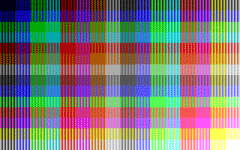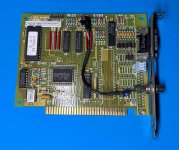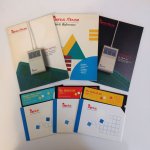chjmartin2
Veteran Member
- Joined
- Dec 25, 2012
- Messages
- 503
Hi,
I'm not sure why I didn't post this before but watching 8-Bit Guy's Super CGA Video it occurred to me that there was a mention of an odd 136 color mode and he commented "that must be some kind of composite thing." Well, this made me remember that I played with composite output on my Plantronics Compatible PVC4 card to display really nice 160x200x256 color images. I don't know if the color combos actually equals 256 colors. I used the below image and captured it, then scaled it down to the right count and took those color values. I am sure @reenigne would be able to tell us the right math but this is how I did it. Anyway the converter takes in a 160x200 RGB BMP and outputs a BMP file, then it has to be converted to GIF. The file can then be viewed using Compushow (but make sure to turn off dither!) Here is the demo file I used:

Anyway, it outputs this image on a composite screen:
I took this capture and then calculated RGB values for it. Again there is certainly better math but you'll see it works. Here is the Paradise PVC4 card (I don't know if that is actually the card, but certainly it has the chipset. Take note of the composite output which is part of the PVC4 with some additional circuitry. This is why you can modify a computer that uses the PVC4 to put out composite.)

Here is a quick demo view:

There is a zip file attachment of the GIF files in the slideshow ready to use on real hardware. I don't believe there is an emulator out there that would support this. I'll release the converter if anybody expresses interest.
Here is a capture from tonight of all of the images in the zip file on this post.
Thanks,
Chris
I'm not sure why I didn't post this before but watching 8-Bit Guy's Super CGA Video it occurred to me that there was a mention of an odd 136 color mode and he commented "that must be some kind of composite thing." Well, this made me remember that I played with composite output on my Plantronics Compatible PVC4 card to display really nice 160x200x256 color images. I don't know if the color combos actually equals 256 colors. I used the below image and captured it, then scaled it down to the right count and took those color values. I am sure @reenigne would be able to tell us the right math but this is how I did it. Anyway the converter takes in a 160x200 RGB BMP and outputs a BMP file, then it has to be converted to GIF. The file can then be viewed using Compushow (but make sure to turn off dither!) Here is the demo file I used:

Anyway, it outputs this image on a composite screen:
I took this capture and then calculated RGB values for it. Again there is certainly better math but you'll see it works. Here is the Paradise PVC4 card (I don't know if that is actually the card, but certainly it has the chipset. Take note of the composite output which is part of the PVC4 with some additional circuitry. This is why you can modify a computer that uses the PVC4 to put out composite.)

Here is a quick demo view:

There is a zip file attachment of the GIF files in the slideshow ready to use on real hardware. I don't believe there is an emulator out there that would support this. I'll release the converter if anybody expresses interest.
Here is a capture from tonight of all of the images in the zip file on this post.
Thanks,
Chris

